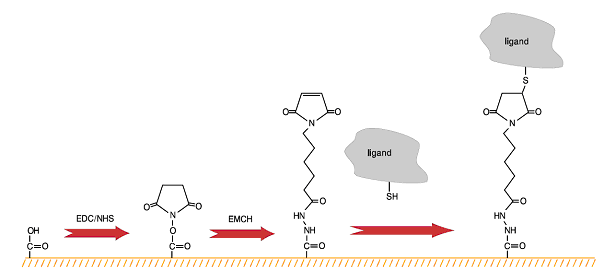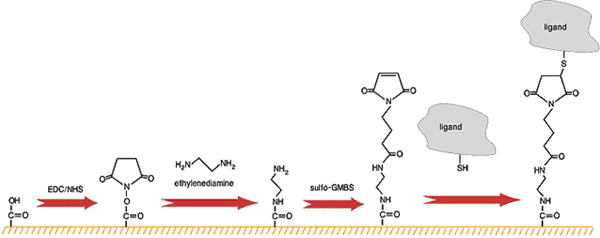Biacore X100 reference portal
Maleimide coupling chemistry
Ligand immobilization by thiol-disulphide exchange is not suitable for experiments where the surface is exposed to reducing agents or high pH, since the disulphide bond is unstable under these conditions. An alternative approach is to use maleimide reagents, resulting in a thioether bond between the ligand and the dextran matrix.
Chemistry
EMCH is first coupled to the surface via the terminal hydrazide group after activation of the dextran matrix with EDC/NHS. Ethanolamine with neutral pH is used to deactivate excess reactive esters. Thiol groups on the injected ligand then react with the maleimide group to form a stable thioether linkage. Excess maleimide groups are deactivated with cysteine/NaCl.

Maleimide coupling using EMCH
Immobilization procedure overview
The general pattern of steps involved in immobilizing ligand is the same for essentially all covalent immobilization methods:
- Activate the surface by injection of appropriate reagents.
- Inject the ligand solution.
- Inject reagent to deactivate remaining active groups on the surface and remove non-covalently bound ligand.
There may be additional steps depending on the properties of the ligand, the type of sensor surface and the details of the chemistry used.
Lab protocol
Lab procedure Maleimide coupling to Biacore sensor chips using EMCH or BMPH is available for download on www.cytivalifesciences.com/solutions/protein-research/Interaction-analysis-with-Biacore-surface-plasmon-resonance-SPR/Get-started-with-surface-plasmon-resonance-SPR-interaction-analysis
Ligand immobilization by thiol-disulphide exchange is not suitable for experiments where the surface is exposed to reducing agents or high pH, since the disulphide bond is unstable under these conditions. An alternative approach is to use maleimide reagents, resulting in a thioether bond between the ligand and the dextran matrix.
Chemistry
In the sulfo-GMBS coupling approach, ethylenediamine is coupled to the surface to provide a surface with amine functionality. Sulfo-GMBS reacts with the amine groups to form a surface with maleimide function that can be used to attach thiol-containing ligands. Excess maleimide groups are deactivated with cysteine/NaCl. Note that the amine surface is not stable and should be derivatized with sulfo-GMBS directly after preparation.

Maleimide coupling using sulfo-GMBS.
Immobilization procedure overview
The general pattern of steps involved in immobilizing ligand is the same for essentially all covalent immobilization methods:
- Activate the surface by injection of appropriate reagents.
- Inject the ligand solution.
- Inject reagent to deactivate remaining active groups on the surface and remove non-covalently bound ligand.
There may be additional steps depending on the properties of the ligand, the type of sensor surface and the details of the chemistry used.
Lab protocol
Lab procedure Maleimide coupling to Biacore sensor chips using sulfo-GMBS is available for download on www.cytivalifesciences.com/solutions/protein-research/Interaction-analysis-with-Biacore-surface-plasmon-resonance-SPR/Get-started-with-surface-plasmon-resonance-SPR-interaction-analysis
Panel 2 header
Lorem ipsum dolor sit amet, consectetur adipisicing elit. Repellendus aliquid tempore natus voluptates repudiandae, eos dolorem libero inventore, quod incidunt, asperiores. Reiciendis itaque enim pariatur, blanditiis minima autem quo a nulla, obcaecati quis, excepturi atque ab rerum! Sequi molestias vel eum, hic, perspiciatis eius suscipit reprehenderit molestiae vitae similique.
Panel 3 header
Lorem ipsum dolor sit amet, consectetur adipisicing elit. Repellendus aliquid tempore natus voluptates repudiandae, eos dolorem libero inventore, quod incidunt, asperiores. Reiciendis itaque enim pariatur, blanditiis minima autem quo a nulla, obcaecati quis, excepturi atque ab rerum! Sequi molestias vel eum, hic, perspiciatis eius suscipit reprehenderit molestiae vitae similique.

Panel 4 header
Lorem ipsum dolor sit amet, consectetur adipisicing elit. Repellendus aliquid tempore natus voluptates repudiandae, eos dolorem libero inventore, quod incidunt, asperiores. Reiciendis itaque enim pariatur, blanditiis minima autem quo a nulla, obcaecati quis, excepturi atque ab rerum! Sequi molestias vel eum, hic, perspiciatis eius suscipit reprehenderit molestiae vitae similique.
Panel 4 header 2
Lorem ipsum dolor sit amet, consectetur adipisicing elit. Repellendus aliquid tempore natus voluptates repudiandae, eos dolorem libero inventore, quod incidunt, asperiores. Reiciendis itaque enim pariatur, blanditiis minima autem quo a nulla, obcaecati quis, excepturi atque ab rerum! Sequi molestias vel eum, hic, perspiciatis eius suscipit reprehenderit molestiae vitae similique.
Panel 5 header
Lorem ipsum dolor sit amet, consectetur adipisicing elit. Repellendus aliquid tempore natus voluptates repudiandae, eos dolorem libero inventore, quod incidunt, asperiores. Reiciendis itaque enim pariatur, blanditiis minima autem quo a nulla, obcaecati quis, excepturi atque ab rerum! Sequi molestias vel eum, hic, perspiciatis eius suscipit reprehenderit molestiae vitae similique.
Panel 5 header 2
Lorem ipsum dolor sit amet, consectetur adipisicing elit. Repellendus aliquid tempore natus voluptates repudiandae, eos dolorem libero inventore, quod incidunt, asperiores. Reiciendis itaque enim pariatur, blanditiis minima autem quo a nulla, obcaecati quis, excepturi atque ab rerum! Sequi molestias vel eum, hic, perspiciatis eius suscipit reprehenderit molestiae vitae similique.
Panel 5 header 3
Lorem ipsum dolor sit amet, consectetur adipisicing elit. Repellendus aliquid tempore natus voluptates repudiandae, eos dolorem libero inventore, quod incidunt, asperiores. Reiciendis itaque enim pariatur, blanditiis minima autem quo a nulla, obcaecati quis, excepturi atque ab rerum! Sequi molestias vel eum, hic, perspiciatis eius suscipit reprehenderit molestiae vitae similique.